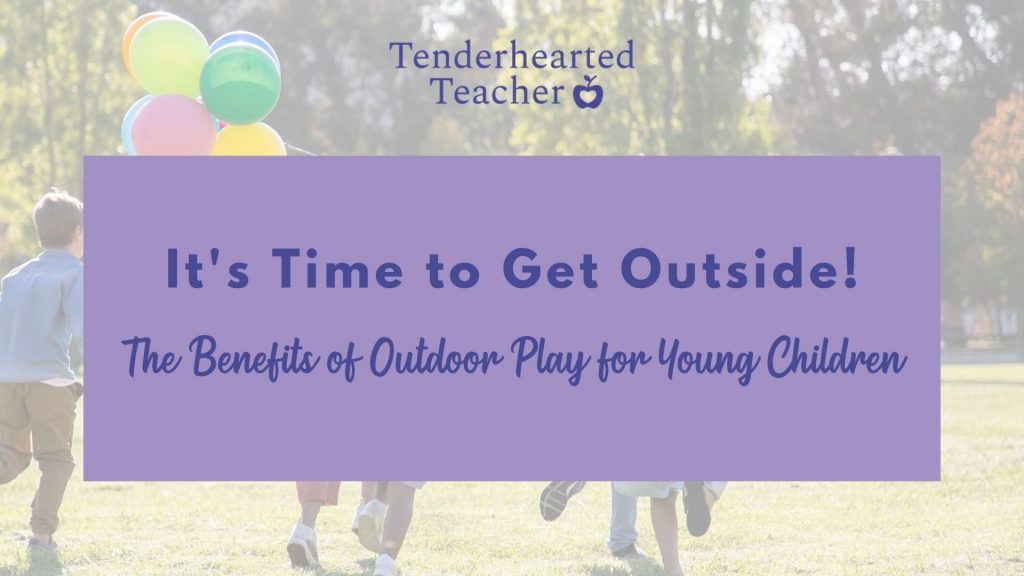
Please note: This post contains affiliate links. As an Amazon Associate, I earn from qualifying purchases. Therefore, if you buy something through these links I will receive a small commission at no extra cost to you. Thank you for your support.
There are countless reasons to love the spring and summer months. The sunshine, fresh air, beautiful flowers, etc. all help to energize us and get us out of our winter funk. But, did you know that getting outside with our little ones can help their overall development too? Stick around and I will share why outdoor play for preschool is such a good idea.
Why We Need Outdoor Play for Preschool More Than Ever
According to the Centre of Excellence for Early Childhood Development (CEECD), “Children are hard-wired to need nature and to play in their natural environments. Research shows that unstructured play that takes place outdoors is vital to children’s social, emotional, cognitive, and physical development.”
However, a recent report by Michigan State University found children are spending less time outdoors nowadays than in previous generations. The average American child (between the ages of 6-17) only spends about 7 minutes a day in outdoor, unstructured play.
That number is pretty astonishing especially because Shape America (Society of Health and Physical Educators) advises that children, 5 and up, should get at least 60 minutes of unstructured play a day. They recommend even more time for preschoolers! They state they should engage in at least 60 minutes of structured physical activity and another 60 minutes (at minimum) of unstructured physical play each day. This includes both indoor and outdoor play experiences.
So what are the consequences of too little physical play? The National Wildlife Federation (NWF) states,
The nature of childhood has changed. American childhood has moved indoors during the last two decades, taking a mental and physical toll on today’s kids. The negative impact of decreased time outdoors includes a doubling of the childhood obesity rate—accompanied by an incremental hundred billion dollar cost to our health care system—as well as declining creativity, concentration, and social skills.
This scary reality has led many states to push for mandatory recess to help counteract these frightening statistics. Schools are trying to incorporate more outdoor time during the school day to give our kids a much-needed and deserved break. But, it’s equally as important for parents to do the same at home. This type of play is essential in nourishing our children’s minds and bodies (in more ways than one!)
Unstructured vs. Structured Play
Before we get into the benefits of outdoor play. Let’s first discuss its two types: unstructured and structured. Structured play is generally adult-led with a set goal or end result in mind. It also has established rules and expectations. An example of this is a game of kickball or baseball. Unstructured play, on the other hand, is child-led and open-ended. These activities can have set rules as well. However, they are generally determined by the children engaged in the play. Children pretending to be rabbits as they hop around in the grass is a simple example of unstructured play. Both types of play are valuable and essential to a child’s development. Therefore, providing ample opportunities for both is ideal.
Benefits of Outdoor Play for Preschool Children
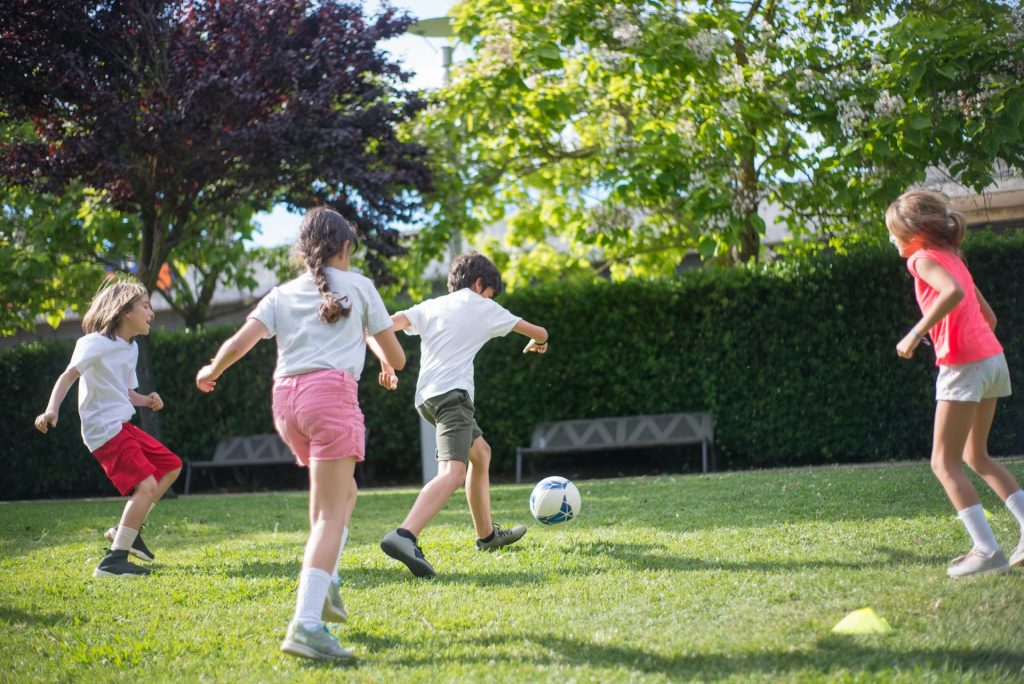
The American Academy of Pediatrics (AAP) lists numerous benefits of play. For example, they state “Collaboration, negotiation, conflict resolution, self-advocacy, decision-making, a sense of agency, creativity, leadership, and increased physical activity are just some of the skills and benefits children gain through play.”
I’ve actually written a bit about the importance of play before as well as how to support the stages of play development. But, for now, let’s talk a little more about the benefits of outdoor play specifically.
Physical
It promotes many physical benefits including enhanced fitness skills, better coordination, and improved fine and gross motor development. Children strengthen their whole bodies by running, jumping, rolling, climbing, etc. They also enhance their fine motor muscles by climbing ladders, hanging on monkey bars, digging in sand/dirt, writing with sidewalk chalk, and more. Playing outside also provides exposure to Vitamin D. This is known to support bone development and a healthy immune system. Additionally, research shows that children who play outside every day get better sleep.
Social-emotional
Outdoor play also provides opportunities for children to enhance their social-emotional skills. When children play and collaborate together, through structured and unstructured games, they are learning how to appropriately interact with one another. They are also learning how to take turns, self-regulate, self-advocate, problem-solve, take risks, empathize, and even help each other.
Cognitive
The great outdoors is also ripe for STEM (science, technology, engineering, and math) learning. It is the perfect environment to explore all these concepts and more. Here are a few examples. Children learn about science while planting in the garden or learn math as they count the number of monkey bars on the playground. Additionally, they learn how to use technology as they snap photos of flowers with a smartphone. And, finally, they learn about engineering as they build an outdoor fort!
Environmental Awareness
Children who play outside are also more in tune with nature and their surroundings. They gain an appreciation for plants and wildlife. They also have a better understanding of their 5 senses. Let’s go back to the gardening example we just mentioned. A simple moment in the garden can give a child the opportunity to feel the breeze on their face, smell the fragrant sweetness of fresh flowers, see insects flying or crawling around, hear the water pour from the watering can, and taste a ripe tomato off of the vine.
Tips for Outdoor Play for Preschool
What can you do as a parent or caregiver to ensure your child receives the benefits of outdoor play? Here are a few simple tips.

1. Make sure the play environment is safe.
Safety is always a priority. I recommend surveying the play space to ensure that loose toys and playground equipment are in proper working order. In addition, it’s important to talk about expectations as well as to model safe and appropriate behaviors with your children before you engage in any type of activity.
2. Don’t be afraid of “Big Body or Risky Play.”
Speaking of safety, many parents and caregivers have shied away from rough and tumble play (a.k.a. risky or big body) for several reasons. Mainly, they fear that it can cause aggressive behavior and/or cause their child to get hurt. But their fears might be misplaced. The NWF states risky play “appears to be an ideal context to develop the ability to handle risk; children who engage in outdoor risky play learn to assess risk in a more accurate way. Evidence also suggests that allowing children a certain level of autonomy strengthens their self-awareness and ability to self-regulate. This can reduce the likelihood of anxiety, both in childhood and later in life.”
Furthermore, the AAP also states, “Rough-and-tumble play, which is akin to the play seen in animals, enables children to take risks in a relatively safe environment, which fosters the acquisition of skills needed for communication, negotiation, and emotional balance and encourages the development of emotional intelligence.”
With that said, take a step back, at times, to allow your child to freely experiment, explore, and problem-solve on their own. Intervene only when necessary.
3. Use the natural environment to your advantage
Let your surroundings help guide your child’s play experiences. For example, if the play space has hills and slopes use them to explore force, motion, and gravity. If there are lots of rocks and sticks in your yard let your child use them to build. Also, don’t be afraid to go outside in rain (as long as there is no thunder or lightning.) If your child is dressed appropriately, there’s nothing more fun than jumping in puddles!
To Sum it Up
Outdoor play is great for our little ones because it helps them develop social-emotional, physical, and cognitive skills. It also helps them to build confidence, learn about their world, and explore their environment.
Before I go, I wanted to mention one last thing! I recently created a wellness activity book. It’s a great tool to teach young children about mindfulness. It includes exercises for the mind and body such as meditative breathing and yoga poses with instructions. You can easily do these yoga activities outside!
- Research shows mindfulness can improve overall health, increase concentration, boost self-esteem, encourage resilience, help to manage emotions, and even reduce stress
- But, how do we teach our children to be mindful?
- Well, it doesn't have to be difficult! This workbook, created by an experienced early childhood educator, is an introduction to mindful practices for young children
- In it, you'll find simple activities and exercises to promote body, mind, and self-awareness
- Gift a special child in your life with this engaging book to help them create a life-long habit of practicing mindfulness
Now talk to me! What are your favorite outdoor activities to do with your child? Share them in the comments below.
Related Blog Posts:
- Yoga for Preschool: Why it’s a Great Idea for Little Ones
- How Music and Movement Promote Development in Preschoolers
- Typical 4-Year-Old Development: Milestones to Look For
Reference: Yogman, M., Garner, A., Hutchinson, J., Hirsh-Pasek, K., Golinkoff, R. M., Committee On Psychosocial Aspects Of Child And Family Health, & Media, C. O. C. A. (2018, September 1). The power of play: A pediatric role in enhancing development in young children. American Academy of Pediatrics. Retrieved October 2, 2021, from https://pediatrics.aappublications.org/content/142/3/e20182058.
SAVE TO PINTEREST
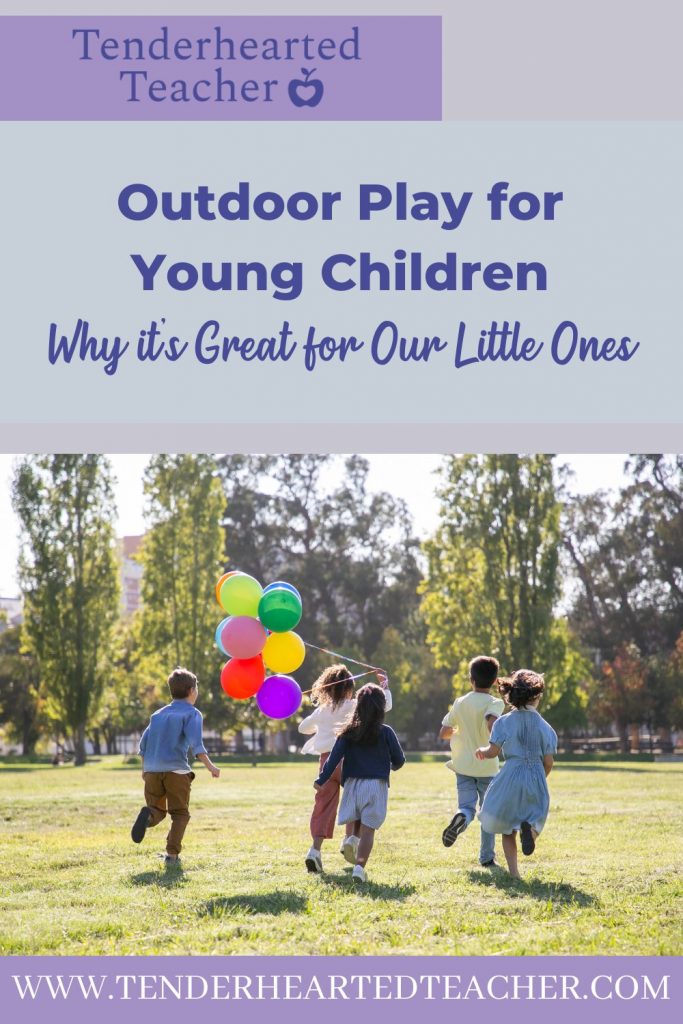

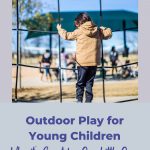
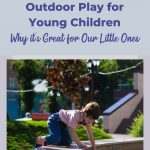
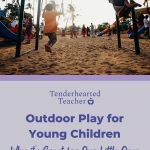
Great tips on outdoor play for littles! I need to come to terms more with the “risky” play you mention too. It’s hard as a first-time mom, but I know there are benefits to it as well like you talk about!
Thanks for sharing!
Thank you, Katie! Yes, I agree. It can be really difficult to let them engage in “risky” play. I recommend starting small and always staying nearby in case you need to step in!
Agreed! It’s so important for little ones and even big ones to play outdoors. Not only is it beneficial for their physical development but also for social ones. My son is an only child so I do my best to schedule him play dates with his school friends but when life is busy and no one is available, I take him to the park. Usually there is another kid that is around and it’s always so interesting to see what their imagination would lead to in terms of play or topic of conversation!
Maureen | http://www.littlemisscasual.com
Same here, Maureen! The playground is a great place for socialization and outdoor play!
This is a great post! I completely agree that kids need to be outdoor more than ever now (if I leave them to their own devices, my daughters would spend all day just watching the Ipad). We try to go out for walks or some unstructured playtime at least once a day. I’m thankful that my daughters love the outdoors, so it’s easy to “entice” them to go out. I struggle at times to let them do the “dirty” things, but I’ve tried to let it go, and let them dig dirt, or jump in muddy puddles. Thanks for sharing this post!
This is absolutely amazing information and so thought provoking. I have young kids and really enjoyed reading this. I knew it was important I just had no idea how much.
Great tips!! Outdoor and unstructured play (whether inside or out) was crucial to my
Boys as they grew up.
Love these tips for outdoor play. My toddler loves going outside, especially when the weather is nice. So keeping these in mind will be helpful.
This was a great read! It’s shocking to read how much time the average kid spends playing outside. Outside play is essential in our house; it generally gets everyone in a good mood!
Lot’s of great information! I couldn’t agree more with how important it is for our kids to be outside and it’s shocking how much this has changed over the years.
Really insightful post! I especially found interesting the benefits of “rough and tumble” play. It seems our first instinct is to stop that sort of interaction. But it’s really interesting to learn the developmental benefits of it!